The Benefits of ProActive® Tanche Olive Water Actives For Skin
Through partnering with an organic olive mill in Nyons, we developed ProActive® Tanche by extracting active molecules from the olive water. During the milling process, roughly 30-40% by weight of fresh olives end up as olive water. As such, the olive water contains rich antioxidants and many other nutrient molecules. We herein detail the benefits of these molecules, which are the essence of ProActive® Tanche, for skin.
Olive oil is about 98% glyceryl esters of fatty acids and 2% minor compounds. This is because, during olive milling, the fatty acid esters are almost exclusively end up in the olive oil, and many of the minor compounds—such as hydrocarbons (e.g. squalene), phytosterols (e.g. β-sitosterol and stigmasterol), tocopherols, carotenoids, pigments (e.g. chlorophylls) and polyphenols—end up in the olive water. As described in ProActive® Tanche: Sustainable Extract from Olive Fruit, the four main groups of phenolic compounds are: (1) secoiridoids (e.g. oleuropein and oleacein), (2) simple phenols (e.g. hydroxytyrosol, tyrosol and vanillic acid), (3) flavonoids, and (4) lignans. Groups 1 and 2 make up the majority of the active molecules in ProActive® Tanche, with group 2 being the hydrolysis derivatives of group 1 (Figure 1).
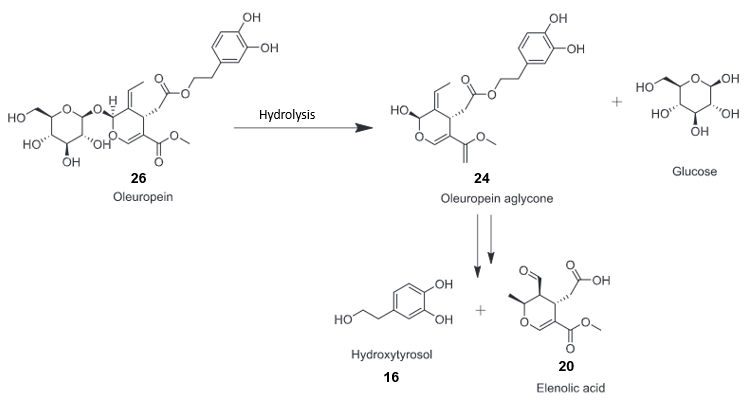
Numerous factors determine the composition and occurrence of specific phenolic compounds in olive water. ProActive® Tanche is derived from fresh, local olive water with high phenolic content and a lower degree of hydrolysis. As such, compared to other reported studies of olive water, ProActive® Tanche contains higher levels of secoiridoids over simple phenols (see ProActive® Tanche: Sustainable Extract from Olive Fruit). Here we focus on oleuropein, hydroxytyrosol, and tyrosol as representatives of secoiridoids and simple phenols in our discussion of their benefits for skin (Figure 2).
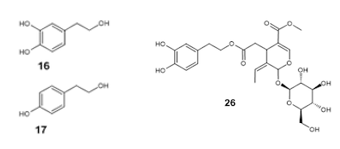
Oleuropein is a secoiridoid glycoside consisting of hydroxytyrosol linked to elenolic acid by an ester bond, with a glucose moiety. Hydroxytyrosol is an ortho-diphenolic molecule, soluble in lipids and slightly soluble in water. Tyrosol is a colorless solid at room temperature with a melting point of 91-92 °C and a partitioning coefficient between oil and water of 0.077.
Antioxidation
Reactive oxygen species (ROS) production via neutrophil activation is mediated by a membrane-bound enzyme complex—NADPH oxidase. The ROS species formed in this process are used by phagocytes to kill infectious agents. However, an overproduction of ROS can cause oxidative stress and cellular damage to macromolecules and is the leading cause of degenerative diseases.
The high antioxidant efficiency of phenolic derivatives is mainly due to the ortho-dihydroxyphenyl moiety, which can donate the hydrogen atom to ROS, thereby acting as a chain breaker and stopping the oxidation process. Oleuropein and hydroxytyrosol are therefore valuable compounds with high antioxidant capacity; they exhibit frequent metal-chelating and free radical scavenging activities. In a study carried out with DPPH (2,2-diphenyl-1-picrylhydrazyl) and ABTS (2,2'-azino-bis/3-ethylbenzothiazoline-6-suphonic acid), one gram of ProActive® Tanche demonstrated antioxidation capability equivalent to 13.3 g of DPPH and 11.7 g of ABTS. This performance level was also compared to those of commonly known strong antioxidants (Figures 3 and 4).
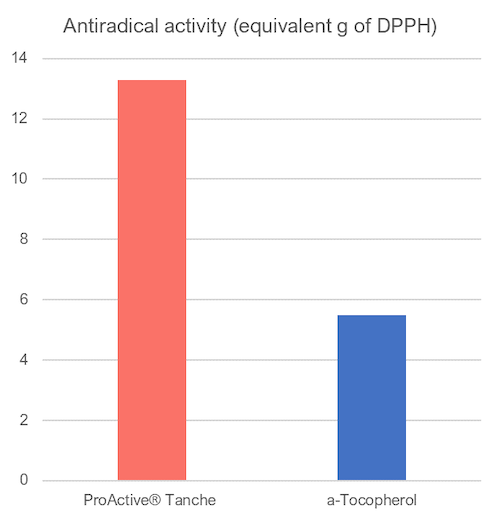
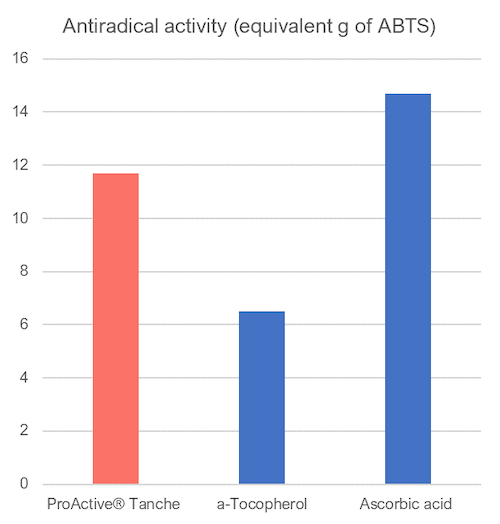
Photoprotection
Skin is the largest human organ and protects us from numerous external conditions. However, skin is highly prone to oxidative stress, especially that caused by exposure to solar ultraviolet (UV) radiation, which leads to ROS formation. UV radiation is the main cause of skin cancer, premature skin aging, and immune dysfunction.
Because of its rich antioxidant content, topical use of ProActive® Tanche can prevent UV radiation-induced formation of ROS in the skin. The photoprotective effects of ProActive® Tanche in human dermal fibroblasts (HDFs) irradiated by UVA were evaluated. The results showed that ProActive® Tanche prevented the increase of intracellular ROS formation induced by UVA treatment, with 66% of scavenging activity at 1% use level. This significantly increased cell viability. The experiment also demonstrated that the treatment of HDFs with UVA radiation induced apoptosis, and the use of ProActive® Tanche played an important role in preventing apoptotic cell death (Figure 5).
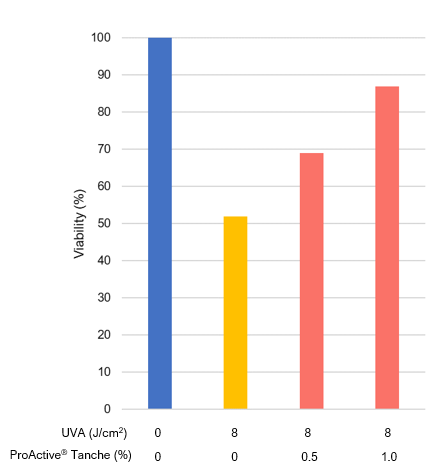
Anti-inflammation
Inflammation is a complex protective skin response to harmful stimuli like pathogens, damaged cells, or irritants. During an inflammatory response, the body eliminates the initial causes of cell injury, clears out damaged tissues, and initiates tissue repair. However, excessive inflammation caused by an overproduction of pro-inflammatory molecules can lead to chronic inflammation diseases such as psoriasis and atopic dermatitis.
Several pro-inflammatory cytokines, such as interleukin-1 beta (IL-1β), interleukin 6 (IL-6), and interleukin 8 (IL-8) are involved in the inflammatory response. When evaluated in human dermal fibroblasts (HDFs) irradiated by UVA, ProActive® Tanche showed strong anti-inflammatory activities, inhibiting the formation of these pro-inflammatory cytokines as well as other enzymes and important molecules involved in the inflammatory process (Figure 6).
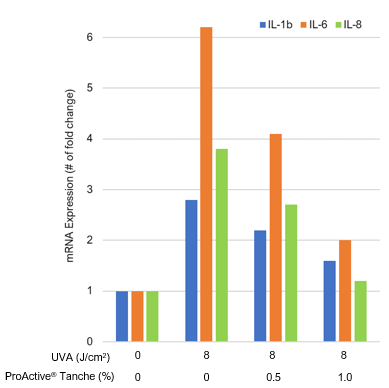
Antimicrobial
Antimicrobial activity of a compound can be quantified using several methods. One method is to determine the minimum inhibitory concentration (MIC), a parameter representing the lowest concentration which results in the maintenance or reduction of the inoculum's viability. Another is to determine the minimum bactericidal concentration (MBC), which represents the concentration at which 99.9% or more of the initial inoculum is killed.
To test antimicrobial activity that is relevant to skincare, ProActive® Tanche’s antimicrobial performance was evaluated on several dermatophytes, which are fungi of the Arthrodermataceae family that commonly cause skin disease in animals and humans, via MIC. Dermatophytes were cultured on Sabouraud glucose agar (SDA), and their response to ProActive® Tanche was assessed in Sabouraud glucose broth (SDB). ProActive® Tanche incorporated at levels greater than or equal to 1% effectively controlled the growth of these microorganisms (Table 1).
